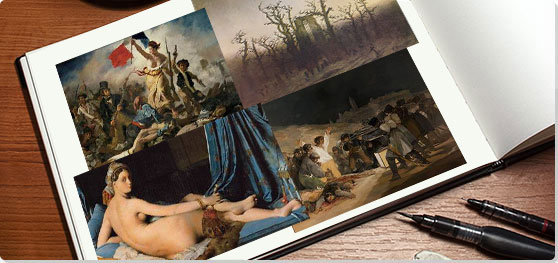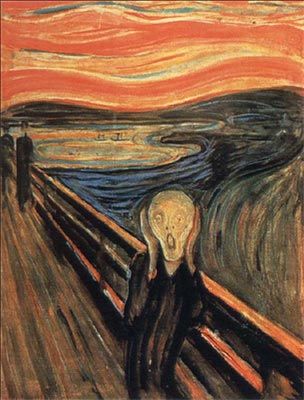Summary of Romanticism
At the end of the 18th century and well into the 19th, Romanticism quickly spread throughout Europe and the United States to challenge the rational ideal held so tightly during the Enlightenment. The artists emphasized that sense and emotions - not simply reason and order - were equally important means of understanding and experiencing the world. Romanticism celebrated the individual imagination and intuition in the enduring search for individual rights and liberty. Its ideals of the creative, subjective powers of the artist fueled avant-garde movements well into the 20th century.
Romanticist practitioners found their voices across all genres, including literature, music, art, and architecture. Reacting against the sober style of Neoclassicism preferred by most countries' academies, the far reaching international movement valued originality, inspiration, and imagination, thus promoting a variety of styles within the movement. Additionally, in an effort to stem the tide of increasing industrialization, many of the Romanticists emphasized the individual's connection to nature and an idealized past.
Key Ideas & Accomplishments
- In part spurred by the idealism of the French Revolution, Romanticism embraced the struggles for freedom and equality and the promotion of justice. Painters began using current events and atrocities to shed light on injustices in dramatic compositions that rivaled the more staid Neoclassical history paintings accepted by national academies.
- Romanticism embraced individuality and subjectivity to counteract the excessive insistence on logical thought. Artists began exploring various emotional and psychological states as well as moods. The preoccupation with the hero and the genius translated to new views of the artist as a brilliant creator who was unburdened by academic dictate and tastes. As the French poet Charles Baudelaire described it, "Romanticism is precisely situated neither in choice of subject nor in exact truth, but in a way of feeling."
- In many countries, Romantic painters turned their attention to nature and plein air painting, or painting out of doors. Works based on close observation of the landscape as well as the sky and atmosphere elevated landscape painting to a new, more respectful level. While some artists emphasized humans at one with and a part of nature, others portrayed nature's power and unpredictability, evoking a feeling of the sublime - awe mixed with terror - in the viewer.
- Romanticism was closely bound up with the emergence of newly found nationalism that swept many countries after the American Revolution. Emphasizing local folklore, traditions, and landscapes, Romanticists provided the visual imagery that further spurred national identity and pride. Romantic painters combined the ideal with the particular, imbuing their paintings with a call to spiritual renewal that would usher in an age of freedom and liberties not yet seen.
Overview of Romanticism
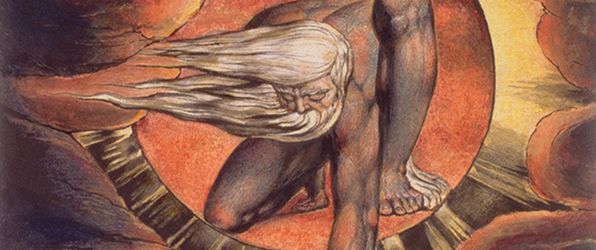
When he was four years old, William Blake had a vision of "the Heavenly host crying Holy Holy Holy is the Lord God Almighty!" Later, expressed in his poetry and visual art, his prophetic visions and belief in the "real and eternal world" of the imagination resulted in the unknown artist being acknowledged as the "father of Romanticism."
Artworks and Artists of Romanticism
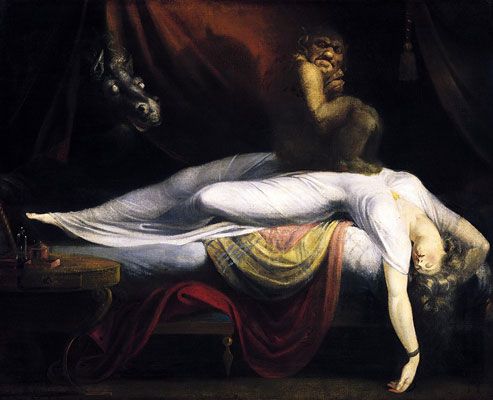
The Nightmare
Fuseli's strange and macabre painting depicts a ravished woman, draped across a divan with a small, hairy incubus sitting on top of her, staring out menacingly at the viewer. A mysterious black mare with white eyes and flaring nostrils appears behind her, entering the scene through lush, red curtains. We seem to be looking at the effects and the contents of the woman's dream at the same time.
Fuseli's ghastly scene was the first of its kind in the midst of The Age of Reason, and Fuseli became something of a transitional figure. While Fuseli held many of the same tenets as the Neoclassicists (notice the idealized depiction of the woman), he was intent on exploring the dark recesses of human psychology when most were concerned with scientific exploration of the objective world. When shown in 1782 at London's Royal Academy exhibition, the painting shocked and frightened visitors. Unlike the paintings the public was used to seeing, Fuseli's subject matter was not drawn from history or the bible, nor did it carry any moralizing intent. This new subject matter would have wide-ranging repercussions in the art world. Even though the woman is bathed in a bright light, Fuseli's composition suggests that light is unable to penetrate the darker realms of the human mind.
The relationship between the mare, the incubus, and the woman remains suggestive and not explicit, heightening the terrifying possibilities. Fuseli's combination of horror, sexuality, and death insured the image's notoriety as a defining example of Gothic horror, which inspired such writers as Mary Shelly and Edgar Allan Poe.
Oil on canvas - Detroit Institute of Art
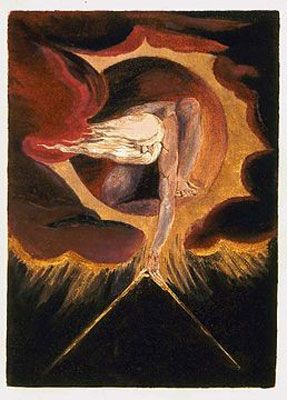
The Ancient of Days from Europe a Prophecy copy B
The Ancient of Days served as the frontispiece to Blake's book, Europe a Prophecy (1794), which contained 18 engravings. This image depicts Urizen, a mythological figure first created by the poet in 1793 to represent the rule of reason and law and influenced by the image of God described in the Book of Proverbs as one who "set a compass upon the face of the earth." Depicted as an old man with flowing white beard and hair in an illuminated orb, surrounded by a circle of clouds, Urizen crouches, as his left hand extends a golden compass over the darkness below, creating and containing the universe. Blake combines classical anatomy with a bold and energetic composition to evoke a vision of divine creation.
Blake eschewed traditional Christianity and felt instead that imagination was "the body of God." His highly original and often mysterious poems and images were meant to convey the mystical visions he often experienced. Europe a Prophecy reflected his disappointment in the French Revolution that he felt had not resulted in true freedom but in a world full of suffering as reflected in England and France in the 1790s. Little known during his lifetime, Blake's works were rediscovered by the Pre-Raphaelites at the end of the 19th century, and as more artists continued to rediscover him in the 20th century, he has become one of the most influential of the Romantic artists.
Relief etching with hand coloring - Glasgow University Library, Glasgow Scotland
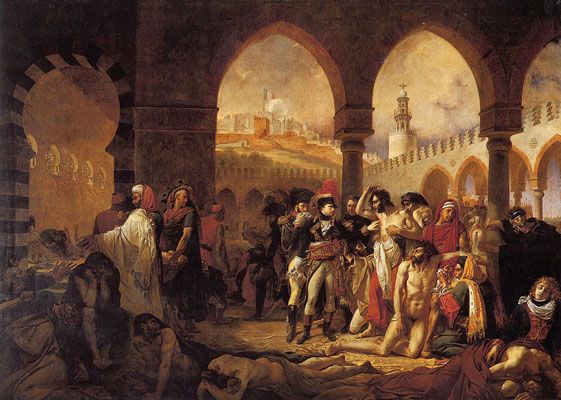
Bonaparte Visits the Plague Stricken in Jaffa
This painting depicts Napoleon I, not yet the Emperor, visiting his ailing soldiers in 1799 in Jaffa, Syria, at the end of his Egyptian Campaign. His troops had violently sacked the city but were subsequently stricken in an outbreak of plague. Gros creates a dramatic tableau of light and shade with Napoleon in the center, as if on a stage. He stands in front of a Moorish arcade and touches the sores of one of his soldiers, while his staff officer holds his nose from the stench. In the foreground, sick and dying men, many naked, suffer on the ground in the shadows. A Syrian man on the left, along with his servant who carries a breadbasket, gives bread to the ill, and two men behind them carry a man out on a stretcher.
While Gros' teacher Jaques Louis David also portrayed Napoleon in all of his mythic glory, Gros, along with some of David's other students, injected a Baroque dynamism into their compositions to create a more dramatic effect than David's Neoclassicism offered. Gros' depiction of suffering and death, combined with heroism and patriotism within an exotic locale became hallmarks of many Romantic paintings.
The use of color and light highlights Napoleon's gesture, meant to convey his noble character in addition to likening him to Christ, who healed the sick. Napoleon commissioned the painting, hoping to silence the rumors that he had ordered fifty plague victims poisoned. The work was exhibited at the 1804 Salon de Paris, its appearance timed to occur between Napoleon's proclaiming himself as emperor and his coronation.
Oil on canvas - Musée du Louvre, Paris France
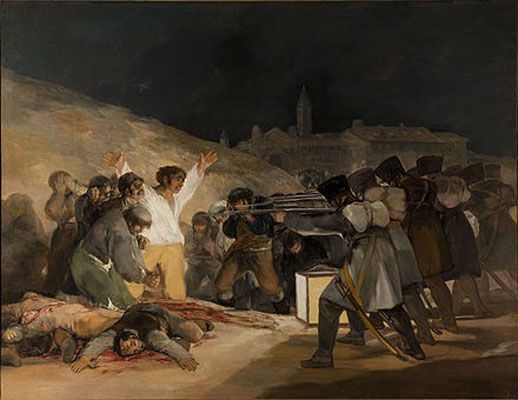
The Third of May 1808
This groundbreaking work depicts the public execution of several Spaniards by Napoleonic troops. On the left, lit up against a hill, a man in a white shirt holds out his arms as he kneels and faces the firing squad. Several men cluster around him with facial expressions and body language expressing a tumult of emotion. A number of the dead lie on the ground beside them and, to their right, a group of people, all with their faces in their hands, knowing they will be next. On the right, the firing squad aims their rifles, forming a single faceless mass. A large square lantern stands between the two groups, dividing the scene between shadowy executioners and victims.
The painting draws upon the traditional religious motifs, as the man in the white shirt resembles a Christ-like figure, his arms extended in the shape of the cross, and a close-up of his hands reveals a mark in his right palm like the stigmata. Yet, the painting is revolutionary in its unheroic treatment, the flatness of its perspective, and its matte almost granular pigments. Additionally, its depiction of a contemporary event experienced by ordinary individuals bucked academic norms that favored timeless Neoclassical vignettes. Goya intended to both witness and commemorate Spanish resistance to Napoleon's army during the Peninsular War of 1808-1814, a war marked by extreme brutality. The painting's dark horizon and sky reflect the early morning hours in which the executions took place, but also convey a feeling of overwhelming darkness.
The art historian Kenneth Clark described it as, "the first great picture which can be called revolutionary in every sense of the word, in style, in subject, and in intention." Goya's revolutionary painting would be instrumental in the rise of Realism's frank depictions of everyday life, of Picasso's declarations against the horrors of war, and the Surrealists' exploration of dream-like subject matter.
Oil on canvas - Museo del Prado, Madrid Spain
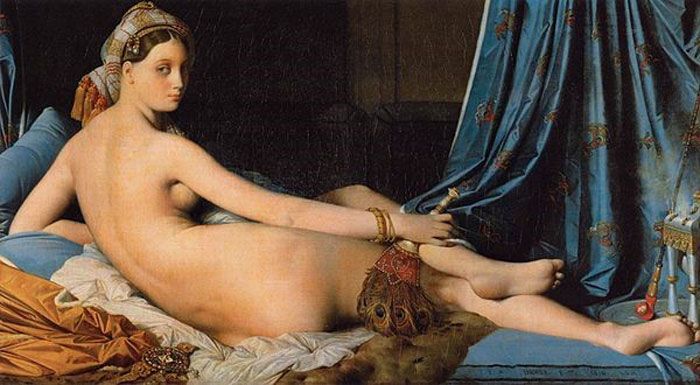
La Grande Odalisque
This painting depicts a reclining nude, a member of a harem, holding a feathered fan amidst sumptuous textiles. Her hair is wrapped in a turban, and a hookah sits at her feet. She turns her head over her shoulder to peer out at the viewer.
Ingres was one of the best known of the Neoclassical painters, and while he continued to defend the style, this work reflects a Romantic tendency. The image recalls Titan's Venus of Urbino (1528) and echoes the pose of Jacque-Louis David's Portrait of Madame Récamier (1809), but a Mannerist influence is also apparent in the figure's anatomical distortions. Her head is a little too small, and her arms do not appear to be the same length. When the work was shown at the 1819 Salon, these distortions prompted critics to claim she had no bones, no structure, and too many vertebrae.
The work is a well-known example of Orientalism. By placing a European nude within the context of a Middle-Eastern harem, the subject could be given an exotic and openly erotic treatment. Subsequent scholars have suggested that because the woman is a concubine in a sultan's harem, the distortions of her figure are symbolic, meant to convey the sultan's erotic gaze upon her figure. As a result, the work points the way to Romanticism's emphasis on depicting a subject subjectively rather than objectively or according to an idealized standard of beauty. Ingres's use of color and his flattening of the figure would be important examples for 20th-century artists like Picasso and Matisse, who also eschewed classical ideals in their representations of individuals.
Oil on canvas - Musée du Louvre, Paris France
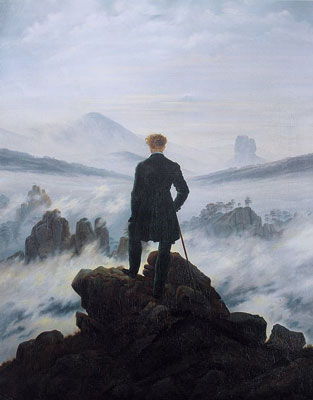
Wanderer Above the Sea of Fog
In this painting, an aristocratic man steps out upon a rocky crag as he surveys the landscape before him, with his back turned toward the viewer. Out of swirling clouds of fog, tall pinnacles of rocks loom, and a majestic peak on the left and a rock formation on the right fill the horizon. Many of Friedrich's landscapes depict a solitary figure in an overwhelming landscape that stands in for a Byronic hero, overlooking and dominating the view.
While Friedrich made plein air sketches in the mountains of Saxony and Bohemia in preparation for this painting, the landscape is essentially an imaginary one, a composite of specific views. The place of the individual in the natural world was an abiding theme of the Romantic painters. Here, the individual wanderer atop a precipice contemplating the world before him seems to suggest mastery over the landscape, but at the same time, the figure seems small and insignificant compared the sublime vista of mountains and sky that stretch out before him. Friedrich was a master of presenting the sublimity of nature in its infinite boundlessness and tempestuousness. Upon contemplation, the world, in its fog, ultimately remains unknowable.
Oil on canvas - Kunsthalle Hamburg, Hamburg German
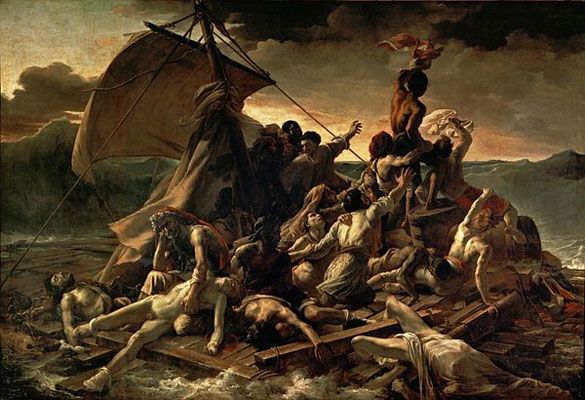
The Raft of the Medusa
Géricault depicts the desperate survivors of a shipwreck after weeks at sea on a wave-tossed raft beneath a stormy sky. At the front of the raft, a black man waves a shirt trying to flag down a ship barely visible on the horizon, while behind him others struggle forward raising their arms in hope of rescue. In the foreground, a disconsolate older man holds onto the nude corpse of his dead son, the body of a man hangs off the raft trailing in the water, and to the far left lies a partial corpse, severed at the waist.
The scene depicts the survivors of the wreck of the Medusa, a French Royal Navy frigate sent to colonize Senegal in 1816. The ship ran aground on a sandbank and began to sink, but there were not enough lifeboats. Some of the survivors built a makeshift raft to reach the African shore, but they were quickly lost at sea. Many died, and others resorted to violence and cannibalism. The artist did months of research, interviewing and sketching the survivors, dissecting cadavers in his studio, and recruiting friends to model, including the painter Delacroix.
Géricault's use of light and shadow as well as organizing the scene along two diagonals creates a dramatic and intense vision. Beginning with the bodies in the lower left, the viewer follows the eyes and gestures of the raft's inhabitants to a man, borne on the shoulders of his companions, waving a cloth - a sign of hope. From the shadows below the sail, one follows another diagonal to the bottom right to see a corpse, partially shrouded, slipping off the raft into the sea. This organization, coupled with the majestic and stormy sky speaks to the Romantic tastes for the terrible and the sublime.
Intended as a profound critique of a social and political system by depicting the tragic consequences and suffering of the marginal members of society, the painting is a pioneering example of protest art. The famous 19th-century art critic Jules Michelet (who coined the term The Renaissance) ascribed a broader view of Géricault's subject, suggesting that "our whole society is aboard the raft of the Medusa."
Oil on canvas - Musée du Louvre, Paris France
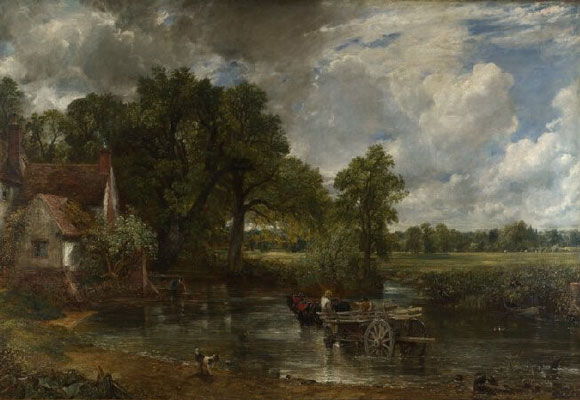
The Hay Wain
This rural landscape depicts a hay wain, a kind of cart, drawn by three horses crossing a river. On the left bank, a cottage, known as Willy Lott's Cottage for the tenant farmer who lived there, stands behind Flatford Mill, which was owned by Constable's father. Constable knew this area of the Suffolk countryside well and said, "I should paint my own places best, painting is but another word for feeling." He made countless en plein air sketches in which he engaged in near scientific observations of the weather and the effects of light.
In Constable's landscape, man does not stand back and observe nature but is instead intimately a part of nature, just as the trees and birds are. The figuring driving the cart is not out of scale with his environment. Constable depicted the oneness with nature that so many of the Romantic poets declared.
Constable found little acclaim in his home country of England because of his refusal to follow a traditional academic path and his insistence on pursuing the lowliest of genres: landscape painting. The French Romantics, however, took him up enthusiastically after seeing this work in the 1824 Paris Salon. His ability to capture the way fleeting atmosphere determines how we see the landscape inspired such artists as Eugène Delacroix. While The Hay Wain may not have been well-received by his countrymen at the time, in 2005 it was the voted second most popular painting in England.
Oil on canvas - The National Gallery, London
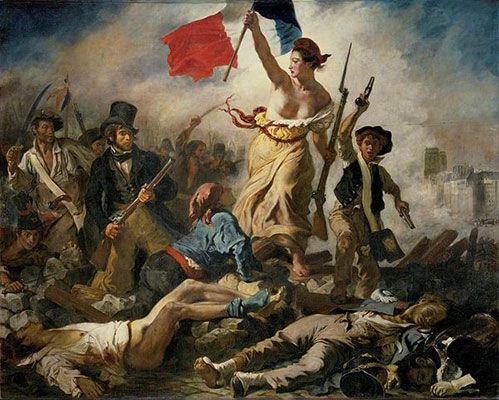
Liberty Leading the People (July 28, 1830)
This famous and influential painting depicts the Paris uprising in July 1830. Delacroix, though, does not present an actual event but an allegory of revolution. A bare-chested woman, representing the idea of Liberty, wears a Phryggian cap, carries a bayonet in one hand and raises the tricolor flag in the other, encouraging the rebellious crowd forward on their path to victory. While her figure and the dress draped over her body evokes the Greek classical ideal, Delacroix includes her underarm hair, suggesting a real person and not just an ideal.
Other contemporary details and political symbols can be found in the portrayal of various classes of Parisian society. A boy, wearing a beret worn by students carries a cartridge pouch on his shoulder and his cavalry pistols, a factory worker brandishes a saber and wears sailor trousers with an apron, and a man wearing the waistcoat and top hat of fashionable urban society is perhaps a self-portrait of Delacroix. The wounded man who kneels at Liberty's feet and looks up at Liberty is a Parisian temporary worker. Each detail in the image carries political significance, as the beret with a white royalist and a red ribbon denotes the liberal faction, and a Cholet handkerchief, a symbol of a Royalist leader, is used to fasten a pistol to a man's abdomen. The right background is relatively empty, and though the towers of Notre Dame place the scene in Paris, parts of the urbanscape are purely imagined.
Delacroix said of the work, "I have undertaken a modern subject, a barricade, and although I may not have fought for my country, at least I shall have painted for her." He had witnessed the event, describing, "Three days amid gunfire and bullets, as there was fighting all around. A simple stroller like myself ran the same risk of stopping a bullet as the impromptu heroes who advanced on the enemy with pieces of iron fixed to broom handles." Delacroix used the dynamic pyramidal arrangement, chiaroscuro, and color to create a scene of clamorous drama that highlights heroism, death, and suffering, quintessential themes of the Romantic movement. Delacroix's bohemianism, his personal vision, and his refusal of academic norms, hallmarks of the Romantic attitude, made him a model for many modern artists.
Oil on canvas - Musée du Louvre, Paris France
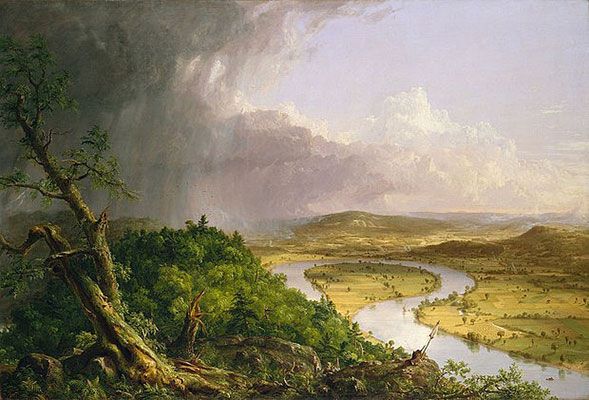
The Oxbow, View from Mount Holyoke, Northampton, Massachusetts, after a Thunderstorm
The American Thomas Cole depicts a view of the winding Connecticut River from Mount Holyoke in Massachusetts. A heavily wooded promontory overlooks a flat plain marked by cultivated fields where the wide river meandered over a long period of time and formed an oxbow, or bend, in its flow, and hills rise in the background. The diagonal created by the promontory divides the scene into two triangles, juxtaposing the stormy and green wilderness on the left with the sunlit and cultivated plains on the right. In the lower right, a single human figure, the artist himself, is depicted at work. Cole thus presents the artist in harmony with nature.
Thomas Cole was among the most important and influential of the Hudson Valley School painters. While traveling in Europe from 1829-1832, the artist traced this view from Basil Hall's Forty Etchings Made with the Camera Lucida in North America in 1827 and 1828. Wanting to counter Hall's criticism of Americans as indifferent to their native landscape, Cole wanted to depict the uniqueness of the American landscape as "a union of the picturesque, the sublime, and the magnificent." This Romantic concept found its way into future depictions of the American landscape by the likes of other painters and photographers, including Ansel Adams.
Oil on canvas - The Metropolitan Museum of Art, New York New York
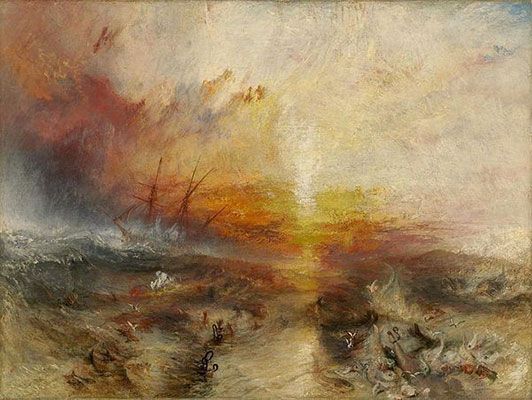
The Slave Ship
This painting depicts a seascape, the ocean a swirl of chaotic waves beneath a stormy sky that is lit up with red and yellow as if on fire. On the horizon, a ship with its sails unfurled appears to be headed directly into rough dark waters. Shackled human forms, some partially glimpsed, are scattered in the foreground like debris, as sharks and other fish circle and close in upon the flailing swimmers.
Turner painted this image after reading Thomas Clarkson's The History and Abolition of the Slave Trade (1808) that recounted how the captain of the slave ship Zong ordered 133 slaves thrown overboard so that he could collect the insurance payments on his human cargo. An ardent abolitionist, Turner hoped that the work would inspire Prince Albert to do more to combat slavery around the globe.
Turner captured the philosopher Edmond Burke's concept of the "sublime," the feeling one senses in the presence of nature's overwhelming grandeur and power. In this image, the human figures, and even the ship on the horizon, are minuscule, and the emphasis on the water and the sky conveys a sense of humanity overwhelmed. The blood red color of the sky and the black caps of the waves convey the emotional intensity of the natural world, and the vertical ray of light from the sun that divides the ocean in half seems almost an apocalyptic vision, the presence of a divine witness. Turner's quick brush strokes create a sense of frenzy and chaos, overpowering the barely visible struggling human forms. His work influenced Romanticism's depiction of nature as a dramatic and tumultuous struggle.
Oil on canvas - Museum of Fine Arts, Boston Massachusetts
Beginnings of Romanticism
The term Romanticism was first used in Germany in the late 1700s when the critics August and Friedrich Schlegal wrote of romantische Poesie ("romantic poetry"). Madame de Staël, an influential leader of French intellectual life, following the publication of her account of her German travels in 1813, popularized the term in France. In 1815 the English poet William Wordsworth, who became a major voice of the Romantic movement and who felt that poetry should be "the spontaneous overflow of powerful feelings," contrasted the "romantic harp" with the "classic lyre." The artists that considered themselves part of the movement saw themselves as sharing a state of mind or an attitude toward art, nature, and humanity but did not rely on strict definitions or tenets. Bucking established social order, religion, and values, Romanticism became a dominant art movement throughout Europe by the 1820s.
Literary Predecessors
An early prototype of Romanticism was the German movement Sturm und Drang, a term usually translated as "storm and stress." Though it was primarily a literary and musical movement from the 1760s to the 1780s, it had a great impact and influence on public and artistic consciousness. Emphasizing emotional extremes and subjectivity, the movement took its name from the title of the play Romanticism (1777) by Friedrich Maxmilian Klinger.
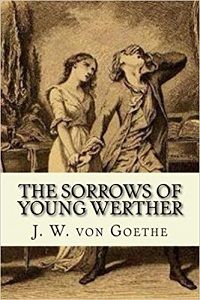
The most famous advocate of the movement was the German writer and statesman Johann Wolfgang von Goethe, whose novel The Sorrows of Young Werther (1774) became a cultural phenomenon. Depicting the emotionally anguished story of a young artist who, in love with the woman who is engaged and then married to the artist's friend, commits suicide, the novel's popularity caused what came to be called "Werther Fever," as young men adopted the protagonist's clothing and manner. Some copycat suicides even occurred, and countries like Denmark and Italy banned the novel. Goethe himself renounced the novel as he later turned away from any association with Romanticism in favor of a classical approach. Nevertheless, the idea of the artist as a solitary genius, emotionally anguished, whose originality and imagination was spurned by the rational world, gripped public consciousness, becoming a model for the romantic hero of the subsequent era.
In the 1800s the British poet Lord Gordon Byron became a celebrity upon the publication of his Childe Harold's Pilgrimage (1812), and the term "Byronic hero," was coined to denote the figure of the lone and brooding genius, torn between his best and worst traits.
Romanticism in the Visual Arts
Both the English poet and artist William Blake and the Spanish painter Francisco Goya have been dubbed "fathers" of Romanticism by various scholars for their works' emphasis on subjective vision, the power of the imagination, and an often darkly critical political awareness. Blake, working principally in engravings, published his own illustrations alongside his poetry that expressed his vision of a new world, creating mythical worlds full of gods and powers, and sharply critiquing industrial society and the oppression of the individual. Goya explored the terrors of irrationality in works like his Black Paintings (1820-23), which conveyed the nightmarish forces underlying human life and events.
In France, the painter Antoine-Jean Gros influenced the artists Théodore Géricault and Eugène Delacroix who subsequently led and developed the Romantic movement. Chronicling the military campaigns of Napoleon Bonaparte in paintings like Bonaparte Visits the Plague Stricken in Jaffa (1804), Gros emphasized the emotional intensity and suffering of the scene.
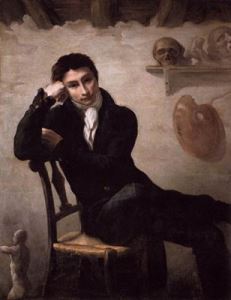
Théodore Géricault's painting The Raft of the Medusa (1819) and Eugene Delacroix's The Barque of Dante (1822) brought Romanticism to the attention of a larger public. Both paintings scandalized the Paris Salons that they were exhibited in, Géricault in 1820 and Delacroix in 1822. Deviating from the Neoclassical style favored by the Academy and using contemporary subject matter outraged the Academy and the larger public. The depiction of emotional and physical extremity and varied psychological states would become the hallmarks of French Romanticism.
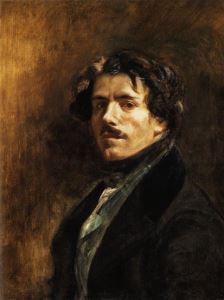
Following Géricault's early death in 1824, Delacroix became the leader of the Romantic movement, bringing to it his emphasis on color as a mode of composition and the use of expressive brushwork to convey feeling. As a result, by the 1820s Romanticism had become a dominant art movement throughout the Western world.
In England, Germany, and the United States, the leading Romantic artists focused primarily on landscape, as seen in the works of the British artist John Constable, the German Caspar David Friedrich, and the American Thomas Cole, but always with the concern of the individual's relation to nature.
A Revolutionary Movement
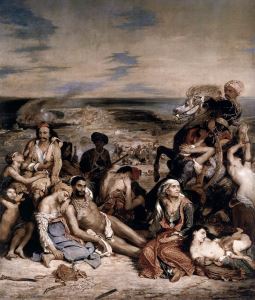
Largely developing during the French Revolution, Romanticism was allied with a revolutionary and rebellious spirit. The rule of reason and law of the Enlightenment was perceived as confining and mechanistic. As a result, artists turned to scenes of rebellion and protest. Géricault intended The Raft of the Medusa (1818-19), inspired by a true account of a shipwreck, as an indictment of the French government's policies that led to the tragedy. Similarly, Turner's The Slave Ship (1840) was intended to influence the British government into a more active abolition policy. Delacroix's Liberty Leading the People (1830) was created to support the uprising of the people of Paris against the restoration government of Charles X. Delacroix also painted a number of works depicting the Greek fight for independence against the Ottoman Empire. His Scène des massacres de Scio (Massacre at Chios) (1824) depicts the survivors of a massacre that occurred when the Ottoman Empire conquered an island of rebellious Greeks and killed or enslaved most of the inhabitants.
The Sublime
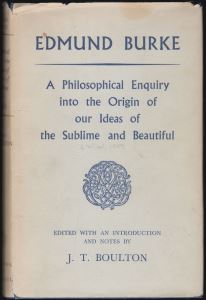
In 1756, the English philosopher Edmund Burke published A Philosophical Enquiry into the Origins of Our Ideas of the Sublime and Beautiful, and in 1790, the German philosopher Emanuel Kant, who explored the relationship between the human mind and experience, developed Burke's notions in Critique of Judgment. The idea of The Sublime came to hold a central place in much of Romanticism in order to counter Enlightenment rationality. Burke explained, "The passion caused by the great and sublime in nature . . . is Astonishment; and astonishment is that state of the soul, in which all its motions are suspended, with some degree of horror. In this case the mind is so entirely filled with its object, that it cannot entertain any other." To experience the sublime, one does not just experience something beautiful but something that overtakes one's rational sense of objectivity. The awe and terror experienced by observing a great storm or an infinite vista make the individual contemplate his or her place in the natural world. This state, though, necessitates that one is at some remove from what one is seeing, that one is not in danger of being physically harmed by the storm or lost in the wilderness. When one tries to comprehend the boundlessness, or formlessness, of nature's power, one feels overwhelmed emotionally. The experience of the sublime triggers self-examination that was crucial to Romanticism. Many Romantic painters sought to evoke the sublime in their landscape paintings, portraying stormy seas and skies witnessed by a solitary individual.
Orientalism
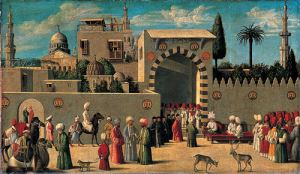
As early as the Renaissance, artists depicted the Middle East through exoticized images, as reflected in The Reception of the Ambassadors in Damascus (1511) by an anonymous Venetian painter. As the art critic Andrew Graham Dixon described, the painting attempted to compress all that made Damascus "vivid and strange, to Venetian eyes, within the scope of a single canvas: figures in turbans; a laden camel on its way to the bazaar; the great Mosque; the citadel; the public baths; private houses and their distinctive, lush walled gardens." In the 19th century a fascination with Middle-Eastern subjects overtook both Neoclassical and Romantic painting, as seen in treatments of the nude like Jean-Auguste-Dominique Ingres' Grande Odalisque (1814), or the popularity of harem scenes like Delacroix's The Women of Algiers (1834). Romantic painters projected desires, fears, and the unknown into their depictions of African and Middle Eastern scenes.
Subsequently, scholars have reevaluated these depictions of an exoticized Middle East. The cultural critic and historian Edward Said coined the term "Orientalism" with his influential book, Orientalism (1978). Said argued that in its depictions of the Middle East, Western art and literature showed a "subtle and persistent Eurocentric prejudice against Arabo-Islamic peoples and their culture." This prejudice was reflected in stereotypical depictions of Middle Eastern culture and people as primitive, irrational, and exotic.
Romanticism: Concepts, Styles, and Trends
Romanticism in Germany
During the Enlightenment, or The Age of Reason, German Romantic painters turned their sights to interior emotions instead of reasoned observations. They looked to previous eras, including the Middle Ages, for examples of men living in harmony with nature and each other. The Nazarenes, a group of painters founded in Vienna in 1809, favored medieval and early Italian Renaissance painting, repudiating the popular Neoclassical style preferred at the time. The leading German Romanticist Caspar David Friedrich worked predominantly in landscape painting and explored man's relation to the land. Landscape painting became an allegory for the human soul as well as a symbol of freedom and boundlessness that subtly critiqued the political restrictedness of the time.
Romanticism in Spain
In the midst of the Peninsular War raged by Napoleon and the Spanish War of Independence, Spanish Romantic painters began exploring more subjective views of landscapes and portraits, valorizing the individual. Francisco de Goya was by far the most prominent of the Spanish Romantics. While he was the official painter for the Royal Court, toward the end of the 18th century, he began exploring the imaginary, the irrational, and the horrors of human behavior and war. His works, including the painting The Third of May, 1808 (1814) and the series of etchings The Disasters of War (1812-15), stand as powerful rebukes of war during the Enlightenment era. Increasingly withdrawn, Goya made a series of Black Paintings (1820-23) that explored the terrors held within the innermost recesses of the human psyche.
Romanticism in France
After the Napoleonic Wars ended with Napoleon in exile, the Romantic painters began challenging the Neoclassicism of Jacques Louis David, the foremost painter during the French Revolution, and the overall Neoclassical style favored by the Academy. Unlike their German counterparts, the French had a larger repertoire of subjects that included portraiture and history painting. Artists such as Jean-Léon Gérôme and Eugène Delacroix created many genre scenes of North Africa, ushering in a vogue for Orientalism, and their dramatically staged compositions of light and color highlighted the horrors of contemporary events and tragedies.
The French also developed a strong sculptural rendition of Romanticism. Géricault experimented in sculpture, creating Nymph and Satyr (1818), a piece that depicted a suggestive and violent encounter between the two mythological figures. He also created works like his Flayed Horse I (c. 1820-24) that combined his anatomical knowledge with the horse, one of his favorite subjects, within a dark and disturbing vision. Romanticist sculpture was drawn to scenes of beasts of prey and fighting animals in which the animals were depicted as a writhing surge of bodies. Portraying a savage beast overwhelming delicate beauty, such works were meant to convey the Romantic sense of terribiltà, the feeling of awe or terror created by the sublime. The most famous of animal sculptors was Antoine-Louis Bayre, whose bronze works like Tiger Surprising an Antelope (c. 1835) became popular among the ruling class.
Romanticism in England
With the exception of William Blake, who practiced a more visionary art, the English Romantic painters favored landscape. Their depictions, however, were not as dramatic and sublime as their German counterparts, but were more naturalistic. The Norwich School was a group of landscape painters that developed from the 1803 Norwich Society of Artists. John Crome, was a founding member of the group and the first president of the Norwich Society, which held annual exhibitions from 1805-1833. Working in both watercolor and oil painting, Crome, like other members of the group emphasized en plein air painting and scientific observation of the landscape. Nonetheless, his work and the work of other artists in the group reflected a Romantic sensibility, as seen in his Boys Bathing on the River Wensum, Norwich (1817), which depicts a precisely observed scene along the Wensum River yet conveys the feeling of human harmony with the sublime beauty of the area.
John Constable was the most influential of the English landscape painters, combining close observation of nature with a deep sensitivity. Rebelling against standard practices of the academy, he wrote to his friend, "For the last two years I have been running after pictures, and seeking the truth at second hand .. I have not endeavored to represent nature with the same elevation of mind with which I set out, but have rather tried to make my performances look like the work of other men .. The great vice of the present day is bravura, an attempt to do something beyond the truth." His use of color was influential on the young Eugène Delacroix, who delighted in the way Constable used dabs of local color and white to create a shimmering light. Color was most radically explored by J.M.W. Turner. Turner was a prolific, yet eccentric and reclusive, artist working in oils, watercolors, and prints. Turner's application of color in rapid strokes created an impastoed and dynamic surface that earned him the epithet "the painter of light." He would be very influential to the Impressionists in the later 19th century and even the Abstract Expressionist Mark Rothko in the mid-20th century.
Romanticism in the United States
American Romanticism found its primary expression in the landscape painting of the Hudson River School, between 1825-1875. While the movement began with Thomas Doughty, whose work emphasized a kind of quietism in nature, the most famous member of the group was Thomas Cole, whose landscapes convey a sense of awe at the vastness of nature. Other noted artists were Frederic Edwin Church, Asher B. Durand, and Albert Bierstadt. The works of most of these artists focused on the landscape of the Adirondacks, White Mountains, and Catskills of the Northeast but gradually branched out into the American West as well as South and Latin American landscapes. Working from sketches that they made outdoors, the artists would create the paintings later in their studios, sometimes using composites of various scenes to create an image of a somewhat imaginary location. The emphasis in such paintings was often upon awe-inspiring, dramatic vistas, where the human figure would appear to be dwarfed, and where an overwhelming and sublime sense of nature's beauty would be conveyed.
Romanticism in Architecture: The Age of Revivals
Romanticism in architecture rebelled against the Neoclassical ideals of the 18th century primarily by evoking past styles. Styles from other periods and regions in the world were incorporated, all with the purpose of evoking feeling, whether a nostalgic longing for the past or for exotic mystery. Accordingly, architecture was dominated by "revival" styles, like the Gothic Revival and the Oriental Revival.
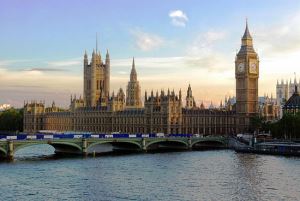
Though the incorporation of Gothic design began in the 1740s, the Gothic Revival became a dominant movement in the 1800s. In France, the historian Arcisse de Caumont's writing provided an intellectual foundation for the interest in antiquities, but it was Victor Hugo's novel, The Hunchback of Notre Dame (1831) that popularized the neo-Gothic craze. In England The Houses of Parliament, also known as the Palace of Westminster, designed and rebuilt by A.W.N. Pugin with architect Charles Berry, exemplifies the Gothic Revival style.
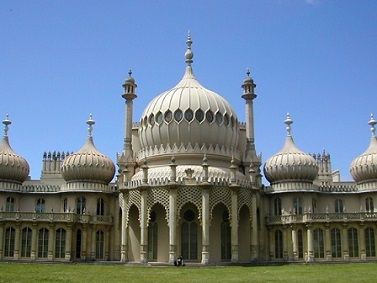
The famous example of Oriental Revival style is the Royal Pavilion (1815-1822) in Brighton, England, built by the architect John Nash. The seaside home of King George IV includes onion domes and minarets and variations on crenellations in the building to create an imposing but exotic presence which includes elements of Asian and Middle-Eastern styles. Napoleon Bonaparte's campaign to Egypt inspired an interest in ancient Egyptian culture, leading to the use of Egyptian columns, obelisks, pylons, and sphinx sculptures. The detention complex "The Tombs," called originally the Houses of Justice, built in New York City in 1838 is a good example of the Egyptian substyle of the Oriental Revival.
Later Developments - After Romanticism
Romanticism began to fade at various times in different countries, but by the 1830s, with the introduction of photography and increasing industrialization and urbanization, artistic styles start trending more toward Realism.
The Pre-Raphaelites
The Romantics' return to earlier styles, such as Medieval art, greatly influenced the later 19th-century British Pre-Raphaelites Edward Burne-Jones, Dante Gabriel Rossetti, and John Everett Millais. These artists depicted medieval, religious, and Shakespearean subject matter filtered through a Romantically-tinged naturalism. They emphasized the imagination as well as the connections between the visual arts and literature.
Turner's and Delacroix's Influence
Turner's and Delacroix's studies and uses of color as well as their vigorous brushstrokes had a significant influence on Impressionism. Their emphasis on color rather than line as a primary mode of composition particularly influenced Georges Seurat's development of Neo-Impressionism and color theory, which became a foundation for later movements like Fauvism and Orphism.
Goya's Influence
Goya's unsentimental representations of Spanish life influenced many Realist artists of the next generation, including French avant-garde painter Édouard Manet. Some of Pablo Picasso's most noted works like Guernica (1937) reflect the continuing influence of Goya on his fellow countrymen. The gruesome results of war and abjection found a new audience who had experienced their own brutal wars in the 20th century.
William Blake's Influence
William Blake's use of image and text to convey a single vision was influential in many modern art movements; Italian Futurism, Orphism, Russian Futurism, Dada, and Surrealism all combined text and image in a variety of ways. Blake's visionary mysticism and rebelliousness also influenced the Beat generation of the 1950's, including the writer Jack Kerouac.
Caspar David Friedrich's Influence
Caspar David Friedrich's symbolic landscapes and their evocation of the sublime had lasting influence among modern artists from the Expressionist Edvard Munch, to the Surrealists Max Ernst and René Magritte, to the later Abstract Expressionists Mark Rothko and Barnett Newman. Friedrich's inspiring visualization of the German landscape was taken up by the Nazis in the 1930s to promote their ideology of Blood and Soil, which espoused racialism and a romanticized nationalism. As a result, it took many years for Friedrich's reputation to recover.
The tenets of Romanticism, emphasizing the primacy of the individual, and, within that individual, the power of the subjective imagination and feeling, became the bedrock of much of modern culture. Surrealism's emphasis on dream life and the subjective subconscious, Expressionism's emphasis on emotional intensity, and the contemporary emphasis on the artist as a cultural celebrity, all derive from Romanticism. The movement has become part of how we think about the individual, one's individual experience and its expression in art. The concept of the artist as a visionary in tune with the deeper nature of reality, which has been part of any number of avant-garde movements, is essentially a Romanticist view.
Useful Resources on Romanticism
-
![Delacroix: and the Rise of Modern Art]() 38k viewsDelacroix: and the Rise of Modern ArtOur PickLecture By The National Gallery, London
38k viewsDelacroix: and the Rise of Modern ArtOur PickLecture By The National Gallery, London -
![J.M.W. Turner: Episode of The Power of Art]() 34k viewsJ.M.W. Turner: Episode of The Power of ArtOur PickBy Simon Schama
34k viewsJ.M.W. Turner: Episode of The Power of ArtOur PickBy Simon Schama -
![John Constable: The Hay Wain (1821)]() 265k viewsJohn Constable: The Hay Wain (1821)Educator Colin Wiggins of The National Gallery, London
265k viewsJohn Constable: The Hay Wain (1821)Educator Colin Wiggins of The National Gallery, London -
![Francisco Goya: Documentary]() 0 viewsFrancisco Goya: DocumentaryBy the BBC
0 viewsFrancisco Goya: DocumentaryBy the BBC -
![Thomas Cole - The Voyage of Life (1842)]() 22k viewsThomas Cole - The Voyage of Life (1842)By the National Gallery of Art
22k viewsThomas Cole - The Voyage of Life (1842)By the National Gallery of Art -
![William Blake: Poet, Artist & Visionary]() 58k viewsWilliam Blake: Poet, Artist & VisionaryEarly Romanticism in England By Ashmolean Museum
58k viewsWilliam Blake: Poet, Artist & VisionaryEarly Romanticism in England By Ashmolean Museum -
![Théodore Géricault: Raft of the Medusa]() 22k viewsThéodore Géricault: Raft of the MedusaIn French, with English subtitles
22k viewsThéodore Géricault: Raft of the MedusaIn French, with English subtitles
 Ask The Art Story AI
Ask The Art Story AI